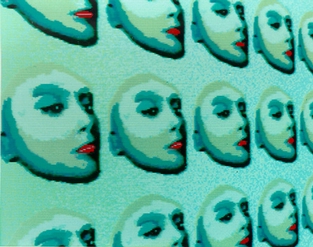Amiga Images
Chong Ho Yu
Amiga Images
Chong Ho Yu
At Bemidji State University, I double-majored in mass
communication and fine arts, focusing on visual media. One
of my favorite media was computer imaging using the
Commodore Amiga platform. The first six images on this page
were created by me using Amiga computers. Although Commodore
has since gone out of business and these graphics may seem
primitive by today's standards, I still share them here
because the Amiga represents a pioneering spirit in computer
graphics, much like Tucker did in the automobile industry.
In the early 1980s, while IBM PCs could only display green
text on a black screen and Mac computers could produce only
black-and-white graphics, the Amiga was ahead of its time
with its ability to generate colorful graphics. Despite its
advanced capabilities, the mindset back then considered such
displays unprofessional, viewing Amigas as mere toys or
gaming computers. Let's explore the brief but remarkable
history of this innovative platform.

Amiga, a Spanish word which means "girl friend," is a line
of computer models introduced by Commodore Corp. in 1985.
This computer platform is the pioneer of multimedia and
multitasking.
Gateway 2000 made a concise comment to Amiga technology:
"Since the introduction of the Amiga 1000 in 1985, Amiga has
represented the embodiment of the efficient use of memory
and hard drive capacity, while pioneering industry
developments in multimedia, 32-bit multi-tasking and
autoconfiguration."
While "celebrating" 20-year birthday of PC in 2001, Doug Barney, a columnist at Network Computing, said, "It is only now, and only with a whole new code set in Windows NT/2000, that we're finally making progress -- gaining features the Commodore gave us some 16 years ago."
The Amiga computer suffered from a mis-perceived image as a
"game" machine. Indeed, once NASA engineers used it for a
space mission. Further, if one considers UNIX as a serious
platform, one should admire the forward-thinking of Amiga
designers. In 1991, the release of System VR4 by AT&T
was a major development of UNIX.
The first platform to port this UNIX version was the Amiga 3000(UX). Multimedia graphics is a major strength of Amiga. Many special effects in TV series such as SeaQuest, RoboCop, and Babylon 5 were made with Amigas. Although the effects in Jurassic Park were produced in SGI workstations, the pre-visuaization was performed in Amigas. Some effects in the James Bond movie, Golden Eye, were also created in this platform..
Back in the 1980s, when RAM was expensive and hard drives
were uncommon, Amiga computers could handle multitasking
from a floppy boot disk with just 128K of RAM. The Amiga's
multimedia functions were closely tied to its multitasking
capability. Although Amigas used Motorola processors,
similar to those in 68K Macs, their chips were customized
for performance.
An Amiga had at least four processors, enabling asymmetrical
multiprocessing, where different processors handled
different tasks. For example, one chip could play music in
the background while another smoothly ran compressed
animations. This multiprocessing feature also allowed an
Amiga to display multiple screens and interlaced video
simultaneously.
Despite the Amiga's advanced multimedia capabilities,
Commodore failed to effectively market and support the
platform. In the 1990s, Amiga lost its competitive edge to
other platforms.
Video Toaster/LightWave 3D, one of the best non-linear video editing tools, was originally custom-made for Amigas. However, this short-term advantage was not enough to save the Amiga. Eventually, Video Toaster/LightWave 3D was ported to more popular platforms. Even Video Toaster magazine recommended that buyers opt for the Windows version of Video Toaster/LightWave 3D rather than the Amiga version.

In the end, mounting debts and unsuccessful product
launches led to the collapse of Commodore Corporation. After
Commodore declared bankruptcy in April 1994, the Amiga
platform underwent a tumultuous yet enduring journey under
various ownerships and adaptations. In 1995, Commodore's
assets, including the Amiga, were sold to the German company
Escom, which formed a subsidiary named Amiga Technologies to
continue developing and producing Amiga computers. Amiga
Technologies attempted to revive the line, producing models
like the Amiga 1200 and 4000T. However, Escom itself went
bankrupt in 1997.
Since then, Amiga Technologies has changed hands many times. While enthusiasts continue to develop hardware and software to keep the Amiga spirit alive, most computer graphics artists have moved on to other platforms.
After the fall of Amiga, the logical alternative to me was the Mac platform. Initially, Mac computers could only produce black-and-white static graphics because of hardware limitations and design decisions aimed at keeping costs low, so that Mac computers could be accessible to a broad audience.
Apple started to enable Macs to create colorful images and
multimedia with the introduction of the Macintosh II in
1987. The Macintosh II was Apple's first computer to support
color graphics, featuring a modular design that allowed
users to add color display cards. This marked a significant
shift, as the Macintosh II could display up to 256 colors
simultaneously from a palette of 16.7 million colors,
enabling more advanced graphics and multimedia applications.
Adobe Photoshop was first released in 1990. Initially, it
was developed exclusively for the Macintosh platform. The
first version for Windows was released in 1992.
Photoshop became the standard in computer graphics by the
mid-1990s due to its powerful features, intuitive interface,
and continuous innovation. The release of Photoshop 3.0 in
1994, which introduced layers, further cemented its
dominance, offering a new level of flexibility and control
in image editing that was unmatched by other software at the
time.
I started using Photoshop during that period, and the last
five images on this page were created with earlier versions
of the software. By today's standards, they may not seem
outstanding, but back in the early and mid-1990s,
Photoshop's capabilities were revolutionary for the field of
computer imaging.
At that time Windows was out of question, because back in
the 1990s, Mac's graphic capability was generally considered
superior to that of Windows. Several factors contributed to
this performance gap.
Macs had superior support for PostScript and high-quality
fonts, which were crucial for desktop publishing and graphic
design. Apple's collaboration with Adobe on the PostScript
language and the inclusion of scalable fonts set Macs apart
from Windows PCs in terms of graphic output quality.
Today Macs and Windows are generally considered to be
equally good in terms of graphic capabilities. Now both Mac
and Windows are built with high-performance hardware,
including powerful processors, advanced GPUs,
high-resolution displays, and large amounts of RAM. This
hardware can handle demanding graphic design and multimedia
tasks effectively.
In addition, both Mac OS and Windows have made significant
improvements to their operating systems, enhancing
performance, stability, and support for graphic-intensive
applications. Hence, I have been using both platforms for
computer imaging for a long time.
Today, even though generative AI art tools like Midjourney,
Adobe Firefly, Stable Diffusion, and DALL·E can produce
stunning graphics from text-based prompts, traditional
imaging generation and editing skills remain relevant and
essential. This is because generative AI tools often cannot
create images exactly as envisioned, making post-processing
still necessary. Thanks to the Amiga platform, the training
and experience I gained laid the foundation for my computer
imaging skills.

Last updated: July 28, 2024